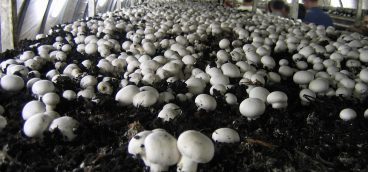Stock for the Mushroom Workers

“The way to make money in the stock market is to buy a stock. Then, when it goes up, sell it. If it’s not going to go up, don’t buy it.” — Will Rogers
Previously in this series: Meddling with Mushrooms
My biggest legal project for Butler County Mushroom Farm was also my last. Mr. Y, the CEO, had been talking for some time about his desire to find a way to allow his employees to participate in BCMF’s increasing value. In those days it wasn’t unusual for the company’s revenues and profits to rise 30% year-over-year.
One day Mr. Y called me in my bullpen. He was sitting in his office with the company’s chief financial officer, and he had a question: Was it possible for BCMF to sell company stock to its employees?
Astonishingly, I actually knew something about this. I didn’t know about it because I was an experienced lawyer with scores of stock offerings under my belt, of course – I’d never handled a single stock offering. I knew it because one of the senior partners in my law firm taught Securities Regulation at Pitt Law School and he’d asked me to give the lectures on exemptions from the registration requirement.
Every public and private company in America is subject to strict rules when it comes to selling their stock. Most stock offerings have to be registered with the Securities and Exchange Commission, after which the SEC will drive you crazy since they assume you are a crook until proven otherwise.
But there are several exemptions from this registration requirement and any company that qualifies for any of them would be nuts not to use it.
I leaned back in my uncomfortable desk chair and began pontificating over the phone about the relative merits of “Reg A” offerings versus “Reg D” offerings, confusing the hell out of Mr. Y but also impressing him mightily. Eventually, he interrupted me to say, “I have no idea what you’re talking about, counselor. Just tell us what we have to do to get this done.”
I spent the better part of the following month more or less working out of BCMF’s smelly offices in West Winstead, putting together the prospectus for the offering. The SEC’s outline of the issues the prospectus needs to cover is itself thirty pages long – single-spaced. Complete prospectuses are often hundreds of pages long.
All this waste of paper happens because the SEC claims to believe that “sunshine is the best disinfectant,” i.e., disclose everything that could possibly be relevant and then prospective buyers can make sensible decisions. There’s just one problem with this idea – no one, no one reads the prospectuses.
The real reason for prospectuses is so that when people buy the stock and then – for whatever reason – the stock price declines, a horde of strike-suit artists (excuse me, plaintiff’s lawyers) can descend on the company and peck it to pieces, claiming that the paragraph on page 261 wasn’t clear enough.
My own view was that we could save a lot of trees if every prospectus consisted of one page, on which the following legend would appear in bright red Arial font, 48 point:
NO ONE BUT A HAREBRAINED IDIOT WOULD BUY THIS STOCK
By the time I’d finished drafting the prospectus for BCMF’s stock offering I knew nearly as much about the company as Mr. Y – and sometimes more. For example, when I was reviewing the company’s governing documents I realized that the articles of incorporation and the bylaws were inconsistent in several particulars. In that case, the articles control, but BCMF had been following the bylaws.
Also, when I sat down with the purchasing manager – his main job was to ensure the supply of high-quality thoroughbred horse manure – he mentioned that the cost of mushroom spawn had skyrocketed over the last year. I duly listed that as a risk factor in the draft prospectus, but when Mr. Y saw it he went nuts.
Mr. Y claimed he’d never been informed about the rising price of spawn, while the purchasing department pointed out that it was noted in all their monthly reports. The upshot of this, as I recall, was that Mr. Y decided to produce his own spawn.
One problem with prospectuses is that the disclosures, if they are going to be complete, will shine a bright light on a company’s vulnerabilities – which can then be exploited by competitors and even reporters. Drafting a prospectus that was good enough to ward off the strike-suit – uh, plaintiff’s lawyers – while not giving away too many secrets turned out to be more art than science. It certainly wasn’t something they taught in law school.
Eventually the prospectus was finalized and the stock sale went forward – the sale was so well-received by BCMF’s employees that the offering was oversubscribed and everyone had to be cut back. Mr. Y was so pleased he immediately called a special shareholder’s meeting for no reason other than that it allowed his employees to show up and act like stockholders.
Just to have something to do at the meeting, Mr. Y gave out awards to employees who’d done especially good jobs that year. As I’ve mentioned in these pages before, when I was a young lawyer I seemed congenitally unable to dress like a lawyer. I could easily see how the other lawyers dressed – dark suit, white or blue button-down shirt, boring necktie – but I simply assumed they had no fashion sense. As for me, I dressed like I was on my way to the disco.
Naturally, I was wearing my disco outfit at the special shareholder’s meeting. At the very end of that meeting Mr. Y called me up on the stage and presented me with a gift certificate to Brooks Brothers in the (then) staggering amount of $500. “Go buy yourself some lawyer’s duds,” he said, bringing down the house.
The metrics we used to price the stock in the offering were the same ones that had been used for years to value BCMF stock – a mix of book value and a multiple of earnings. That was necessary because BCMF wasn’t a public company and therefore there was no obvious market value for the stock.
Unfortunately, the price we set turned out to be the absolute high-water-mark for BCMF stock – after that it was all downhill. But I wasn’t around for the long, slow decline of Moonlight Mushrooms, for reasons we’ll look at next week.
Next up: The Life and Death of Moonlight Mushrooms, Part 5














